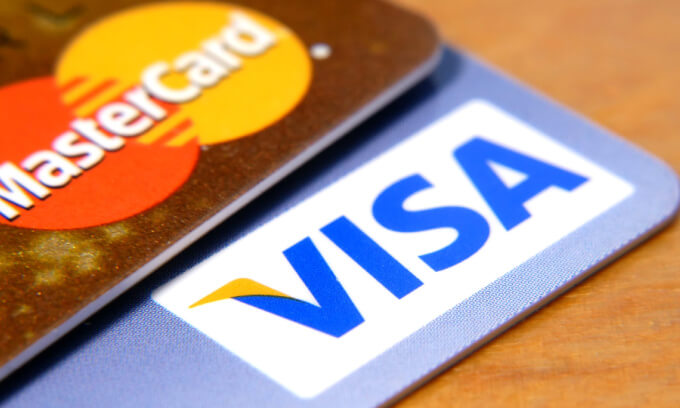What are the main differences between Visa and Mastercard?
Most credit cards look the same – a rectangular piece of plastic with numbers on it – and more often than not, these cards will be stamped with the brand logo of either Visa or Mastercard.
These two companies appear on the lion’s share of credit cards in Australia, according to Statista.com. But these companies have only a small amount of influence over the actual credit card products and benefits that a user may end up signing up for. This is because:
- They only provide the system that allows a payment transaction to take place, rather than distributing cards themselves.
- They do not determine how much interest you could be charged on outstanding balances, nor what types of points you will earn if your card is attached to a rewards program.
- Credit cards from both platforms are accepted just about anywhere in the world.
But there are some minor differences between the two payment platforms:
- Some banks and outlets have “exclusive” arrangements with one payment platform over the other. For example, in 2015 National Australia Bank signed a 10-year agreement with Visa which means until 2025, the bank’s customers will only be offered Visa credit cards.
- “Benefit” programs—perks built into the cards by Visa or Mastercard before the issuing bank applies its conditions—differ slightly. Banks may change these conditions and/or offer their own benefit programs, so it could be a good idea to check out the benefit package conditions on each individual credit card a bank is offering before making a decision.
If Visa and Mastercard are much the same, how do you choose the right credit card?
Australia’s credit card market can feel complex, with hundreds of different types of packages available from a range of financial institutions. Each has its own set of benefits and conditions.
When it comes to choosing the right credit card for your needs, you could start by asking yourself the following questions:
- What will you use the card for? Is it for a one-off purchase? Or will you regularly be buying items on it? Different cards may better suit different purposes.
- Can you afford the repayments? Paying for items on credit means you are borrowing money from a financial institution – going into debt.
- Are there alternatives available? In some cases, it could be worth comparing other types of credit (e.g. personal loans, home equity loans) against the potential long-term costs of having a credit card.
- Would you use the credit card’s extra benefits? Take a look at the card package’s rewards programs and any other benefits it may offer, such as insurance for items purchased.
- What credit card packages and deals are available? Consider what credit card deals and bonuses your bank of choice is offering and how those packages compare to the rest of the market.
What types of Mastercard and Visa credit cards are available from lenders?
While there are a huge range of cards available carrying the Visa or Mastercard logo, most of them can be classified into one of the following categories:
Premium credit cards
Premium credit cards sometimes use names like “platinum”, “signature”, “silver”, “gold” or “black”. These cards are part of a package put together by the bank (sometimes in conjunction with Visa or Mastercard) offering more perks than a standard credit card.
While premium cards offer more benefits than a standard card, they also typically charge higher fees and/or higher interest rates on outstanding balances. In many cases, these cards are only available to higher-income, higher-spending customers, too.
Rewards credit cards
Some credit cards have a rewards program attached, designed to give the user bonuses, either instantly or over the long term, each time they use their card.
These bonuses could include the ability to earn ‘points’ which can be used instead of cash to pay for flights or goods and services. Some rewards programs allow the points to be converted to cash, to be taken off the balance that remains owing on the card.
But most rewards cards have annual fees, spending limits and other restrictions or conditions which can make them more costly to use than other types of cards.
Frequent flyer credit cards
Some credit cards offer specific rewards programs that earn users points to spend on flights and sometimes other goods and services, too, depending on the scheme.
Australian frequent flyers programs include the Qantas Frequent Flyer and Virgin Velocity schemes.
Low rate credit cards
Low rate credit cards typically come with lower purchase rates than other types of cards. That means if you do not pay off the entire balance when the credit card payment is due, the interest charged on your outstanding balance could be lower than what it would be on other, higher-rate credit cards.
But low rate credit cards are generally ‘no frills’ options that tend not to include the rewards programs, perks and bonuses that premium or rewards cards may offer. Their fees could also be higher than some other types of cards, such as “low fee” cards.
Low fee and no fee credit cards
Credit cards typically charge ongoing annual fees to cover the cost of providing the card and any associated benefits, such as rewards programs.
Low fee credit cards typically have lower ongoing fees than other types of cards. There are also no fee credit cards, which do not charge users an annual fee. But there is often a trade-off – some card packages may have low or no fees but offer few extra benefits, while others may have some benefits but charge higher interest rates on overdue balances to pay for them.
Balance transfer credit cards
Some credit cards allow users to add debt from another credit card or cards. Typically, a ‘balance transfer’ card has a lower interest rate than the original card – as low as 0% in some cases – which could potentially help the user to pay off the debt more quickly, or cut down on monthly repayments.
But there are some potential catches to this type of transaction:
- There could be an up-front fee to transfer debt from another card.
- The lower interest rate could be a “promotional rate” which expires after a certain time and then reverts to a higher interest rate.
- There could be ongoing higher fees associated with these cards than other types of credit cards.








